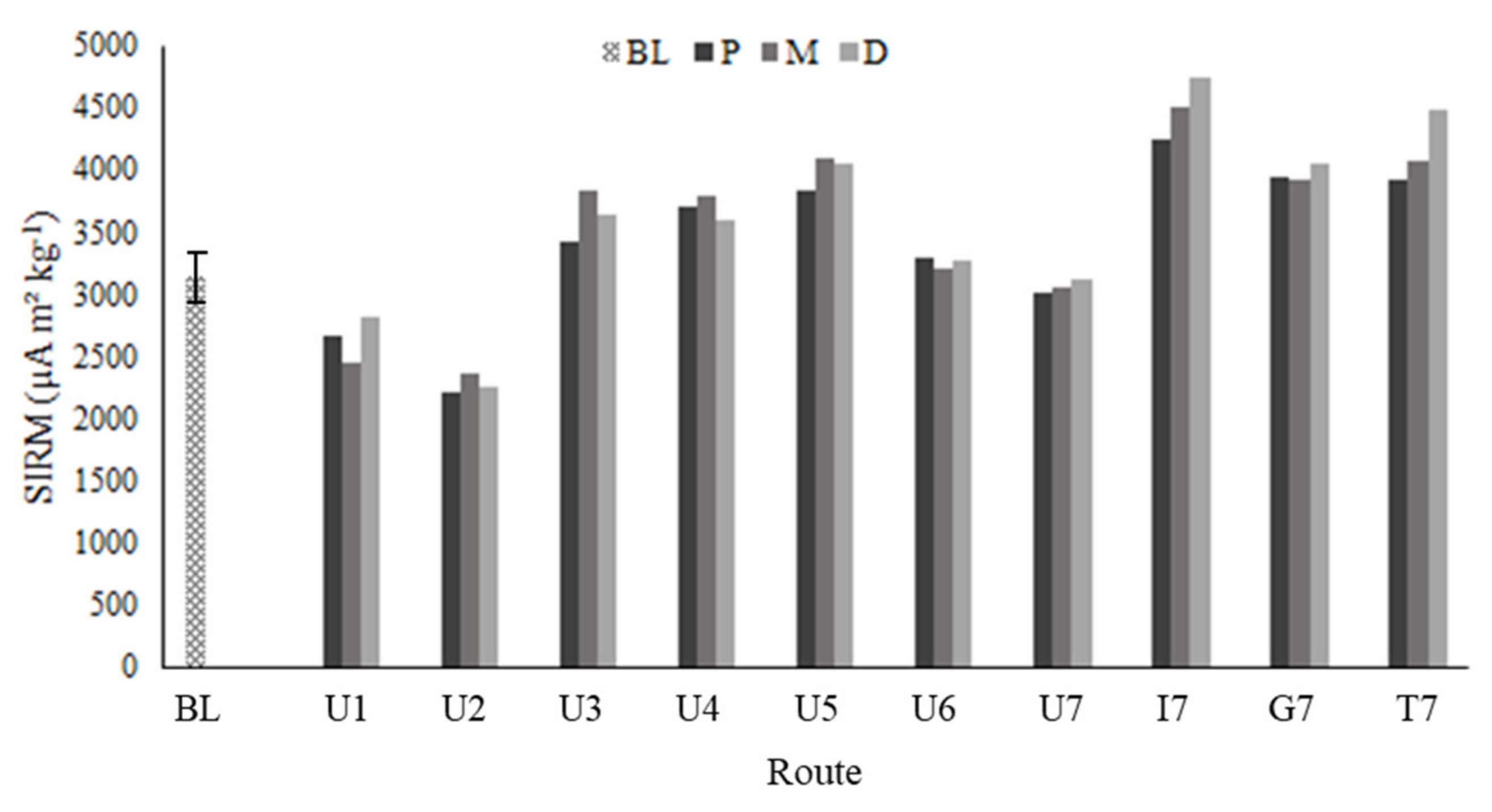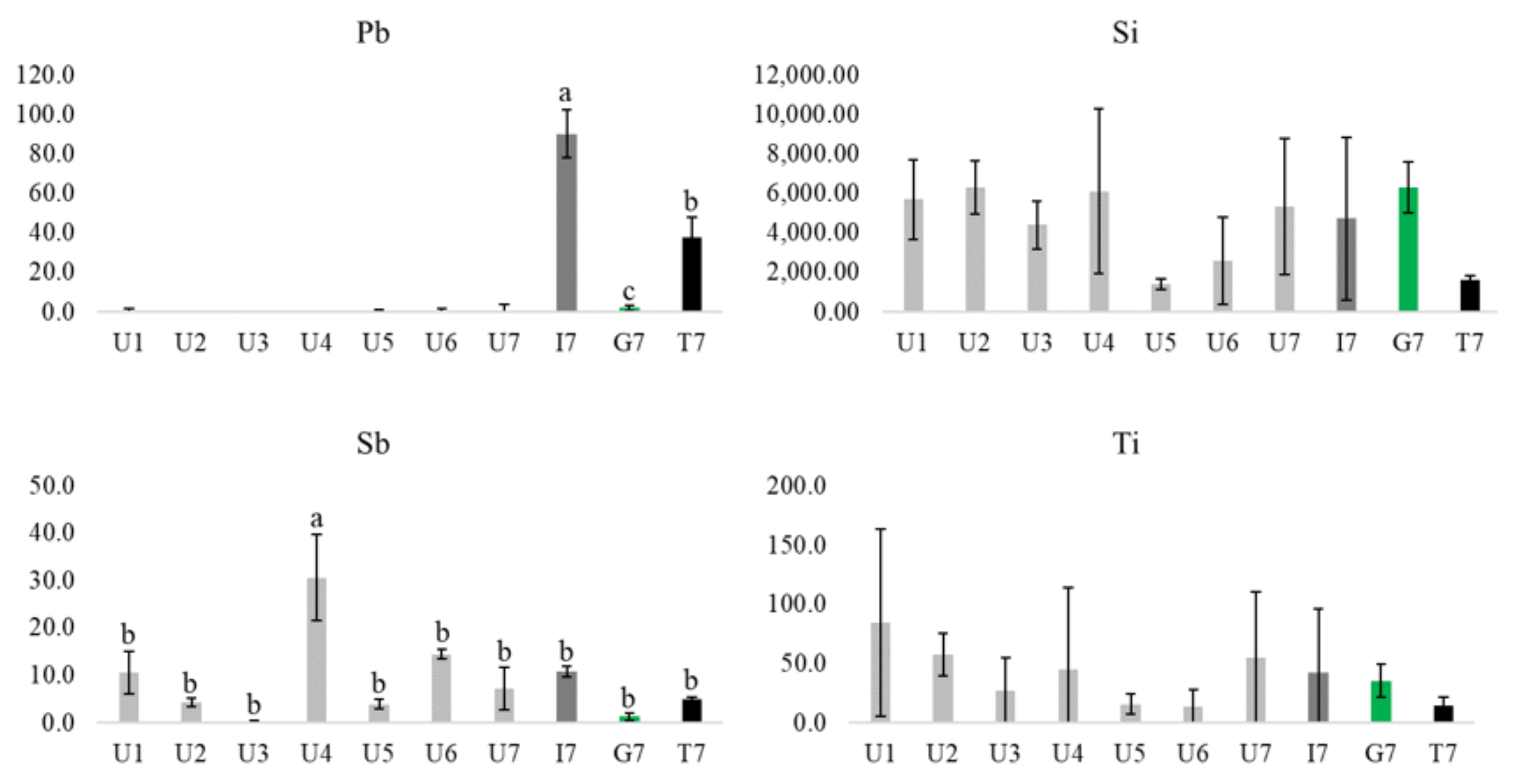Mobile Biomonitoring of Atmospheric Pollution: A New Perspective for the Moss-Bag Approach
Abstract
:1. Introduction
- (i)
- Can the “mobile” moss-bags accumulate airborne elements and what are, if any, the criticisms related to this new approach?
- (ii)
- Can the mobile moss-bags discriminate the different land uses of the investigated routes in term of pollution levels?
- (iii)
- What is the relationship between data from mobile and static biomonitoring systems applied in the same study area?
2. Results
2.1. SIRM Analysis
2.2. Chemical Analysis: Element Accumulation and Flux
2.3. Comparison between Moving and Static Moss-Bags
2.4. Particulate Matter
3. Discussion
4. Materials and Methods
4.1. Moss Material, Study Area and Experimental Design
4.2. SIRM Analysis
4.3. Chemical Analysis
4.4. PM Sampling
4.5. Data Analyses
5. Conclusions
Supplementary Materials
Author Contributions
Funding
Institutional Review Board Statement
Informed Consent Statement
Data Availability Statement
Acknowledgments
Conflicts of Interest
References
- Archibald, A.T.; Folberth, G.; Wade, D.C.; Scott, D. A world avoided: Impacts of changes in anthropogenic emissions on the burden and effects of air pollutants in Europe and North America. Farad. Discuss. 2017, 200, 475–500. [Google Scholar] [CrossRef]
- Brunekreef, B.; Holgate, S.T. Air pollution and health. Lancet 2002, 360, 1233–1242. [Google Scholar] [CrossRef]
- Duan, K.; Sun, G.; Zhang, Y.; Yahya, K.; Wang, K.; Madden, J.M.; Caldwell, P.V.; Cohen, E.C.; McNulty, S.G. Impact of air pollution induced climate change on water availability and ecosystem productivity in the conterminous United States. Clim. Chang. 2017, 140, 259–272. [Google Scholar] [CrossRef]
- Wei, X.; Lyu, S.; Yu, Y.; Wang, Z.; Liu, H.; Pan, D.; Chen, J. Phylloremediation of air pollutants: Exploiting the potential of plant leaves and leaf-associated microbes. Front. Plant. Sci. 2017, 8, 1–23. Available online: https://www.frontiersin.org/articles/10.3389/fpls.2017.01318/full (accessed on 3 November 2021). [CrossRef] [PubMed]
- Oves, M.; Khan, M.S.; Zaidi, A.; Ahmad, E. Soil contamination, nutritive value, and human health risk assessment of heavy metals: An overview. In Toxicity of Heavy Metals to Legumes and Bioremediation; Zaidi, A., Wani, P., Khan, M., Eds.; Springer: Vienna, Austria, 2012; pp. 1–27. [Google Scholar]
- Pope, C.A., III; Burnett, R.T.; Thun, M.J.; Calle, E.E.; Krewski, D.; Ito, K.; Thurston, G.D. Lung Cancer, Cardiopulmonary Mortality, and Long-term Exposure to Fine Particulate Air Pollution. JAMA 2002, 287, 1132–1141. [Google Scholar] [CrossRef] [PubMed] [Green Version]
- Sanità di Toppi, L.; Sanità di Toppi, L.; Bellini, E. Novel coronavirus: How atmospheric particulate affects our environment and health. Challenges 2020, 11, 6. [Google Scholar] [CrossRef]
- Kardel, F.; Wuyts, K.; De Wael, K.; Samson, R. Biomonitoring of atmospheric particulate pollution via chemical composition and magnetic properties of roadside tree leaves. Environ. Sci. Pollut. Res. 2018, 25, 25994–26004. [Google Scholar] [CrossRef] [PubMed]
- Conti, M.E.; Cecchetti, G. Biological monitoring: Lichens as bioindicators of air pollution assessment—A review. Environ. Pollut. 2001, 114, 471–492. [Google Scholar] [CrossRef]
- Kardel, F.; Wuyts, K.; Babanezhad, M.; Vitharana, U.W.A.; Wuytack, T.; Potters, G.; Samson, R. Assessing urban habitat quality based on specific leaf area and stomatal characteristics of Plantago lanceolata L. Environ. Pollut. 2010, 158, 788–794. [Google Scholar] [CrossRef] [PubMed]
- Kardel, F.; Wuyts, K.; Maher, B.A.; Hansard, R.; Samson, R. Leaf saturation isothermal remanent magnetization (SIRM) as a proxy for particulate matter monitoring: Inter-species differences and in-season variation. Atmos. Environ. 2011, 45, 5164–5171. [Google Scholar] [CrossRef]
- Di Palma, A.; Capozzi, F.; Spagnuolo, V.; Adamo, P.; Giordano, S. Atmospheric particulate matter intercepted by moss-bags: Relations to moss trace element uptake and land use. Chemosphere 2017, 176, 361–368. [Google Scholar] [CrossRef]
- Hunt, A.; Jones, J.; Oldfield, F. Magnetic measurements and heavy metals in atmospheric particulates of anthropogenic origin. Sci. Total Environ. 1984, 33, 129–139. [Google Scholar] [CrossRef]
- Goddu, S.R.; Appel, E.; Jordanova, D.; Wehland, F. Magnetic properties of road dust from Visakhapatnam (India)—Relationship to industrial pollution and road traffic. Phys. Chem. Earth Parts A/B/C 2004, 29, 985–995. [Google Scholar] [CrossRef]
- Kapper, K.L.; Bautista, F.; Goguitchaishvili, A.; Bógalo, M.F.; Cejudo-Ruíz, R.; Cervantes, S.M. The use and misuse of magnetic methods to monitor environmental pollution in urban areas. Bol. Soc. Geol. Mex. 2020, 72, 1–44. [Google Scholar] [CrossRef]
- Vuković, G.; Aničić Urošević, M.; Tomašević, M.; Samson, R.; Popović, A. Biomagnetic monitoring of urban air pollution using moss-bags (Sphagnum girgensohnii). Ecol. Ind. 2015, 52, 40–47. [Google Scholar] [CrossRef]
- Sorrentino, M.C.; Wuyts, K.; Joosen, S.; Mubiana, V.K.; Giordano, S.; Samson, R.; Capozzi, F.; Spagnuolo, V. Multi-elemental profile and enviromagnetic analysis of moss transplants exposed indoors and outdoors in Italy and Belgium. Environ. Poll. 2021, 289, 117871. [Google Scholar] [CrossRef] [PubMed]
- Canha, N.; Almeida, S.M.; Freitas, M.C.; Wolterbeek, H.T. Indoor and outdoor biomonitoring using lichens at urban and rural primary schools. J. Tox.Env. Health. Part A 2014, 77, 900–915. [Google Scholar] [CrossRef]
- Capozzi, F.; Di Palma, A.; Adamo, P.; Sorrentino, M.C.; Giordano, S.; Spagnuolo, V.; Indoor, vs. outdoor airborne element array: A novel approach using moss-bags to explore possible pollution sources. Environ. Pollut. 2019, 249, 566–572. [Google Scholar] [CrossRef]
- Zechmeister, H.G.; Rivera, M.; Köllensperger, G.; Marrugat, J.; Künzli, N. Indoor monitoring of heavy metals and NO2 using active monitoring by moss and Palmes diffusion tubes. Environ. Sci. Eur. 2020, 32, 156. [Google Scholar] [CrossRef]
- Capozzi, F.; Giordano, S.; Di Palma, A.; Spagnuolo, V.; De Nicola, F.; Adamo, P. Biomonitoring of atmospheric pollution by moss-bags: Discriminating urban-rural structure in a fragmented landscape. Chemosphere 2016, 149, 211–218. [Google Scholar] [CrossRef] [PubMed]
- Giordano, S.; Adamo, P.; Spagnuolo, V.; Vaglieco, B.M. Instrumental and bio-monitoring of heavy metal and nanoparticle emissions from diesel engine exhaust in controlled environment. J. Environ. Sci. 2010, 22, 1357–1363. [Google Scholar] [CrossRef]
- Turgut, E.T.; Gaga, E.O.; Jovanović, G.; Odabasi, M.; Artun, G.; Ari, A.; Urošević, M.A. Elemental characterization of general aviation aircraft emissions using moss-bags. Environ. Sci. Pollut. Res. 2019, 26, 26925–26938. [Google Scholar] [CrossRef]
- Hofman, J.; Maher, B.; Adrian, A.; Muxworthy, R.; Wuyts, K.; Castanheiro, A.; Samson, R. Biomagnetic monitoring of atmospheric pollution: A review of magnetic signatures from biological sensors. Environ. Sci. Technol. 2017, 51, 6648–6664. [Google Scholar] [CrossRef] [PubMed] [Green Version]
- Amato, F.; Pandolfi, M.; Viana, M.; Querol, X.; Alastuey, A.; Moreno, T. Spatial and chemical patterns of PM10 in road dust deposited in urban environment. Atmos. Environ. 2009, 43, 1650–1659. [Google Scholar] [CrossRef]
- Capozzi, F.; Giordano, S.; Aboal, J.R.; Adamo, P.; Bargagli, R.; Boquete, T.; Di Palma, A.; Real, C.; Reski, R.; Spagnuolo, V.; et al. Best options for the exposure of traditional and innovative moss-bags: A systematic evaluation in three European countries. Environ. Pollut. 2016, 214, 362–373. [Google Scholar] [CrossRef]
- Castanheiro, A.; Wuyts, K.; Hofman, J.; Nuyts, G.; De Wael, K.; Samson, R. Morphological and elemental characterization of leaf-deposited particulate matter from different source types: A microscopic investigation. Environ. Sci. Pollut. Res. 2021, 28, 25716–25732. [Google Scholar] [CrossRef] [PubMed]
- Castanheiro, A.; Samson, R.; De Wael, K. Magnetic- and particle-based techniques to investigate metal deposition on urban green. Sci. Total Environ. 2016, 571, 594–602. [Google Scholar] [CrossRef] [PubMed]
- Capozzi, F.; Sorrentino, M.C.; Di Palma, A.; Mele, F.; Arena, C.; Adamo, P.; Spagnuolo, V.; Giordano, S. Implication of vitality, seasonality and specific leaf area on PAH uptake in moss and lichen transplanted in bags. Ecol. Indic. 2020, 108, 105727. [Google Scholar] [CrossRef]
- García-Seoane, R.; Fernández, J.A.; Chilà, A.; Aboa, J.R. Improving the uptake of pollutants in moss-bags: The wind effect. Ecol. Ind. 2019, 107, 105577. [Google Scholar] [CrossRef]
- Mitchell, R.; Maher, B.A.; Kinnersley, R. Rates of particulate pollution deposition onto leaf surfaces: Temporal and inter-species magnetic analyses. Environ. Pollut. 2010, 158, 1472–1478. [Google Scholar] [CrossRef] [PubMed]
- Castanheiro, A.; Hofman, J.; Nuyts, G.; Joosen, S.; Spassov, S.; Blust, R.; Lenaerts, S.; De Wael, K.; Samson, R. Leaf accumulation of atmospheric dust: Biomagnetic, morphological and elemental evaluation using SEM, ED-XRF and HR-ICP-MS. Atmos. Environ. 2020, 221, 117082. [Google Scholar] [CrossRef]
- Couto, J.A.; Aboal, J.R.; Fernández, J.A.; Carballeira, A. A new method for testing the sensitivity of active biomonitoring: An example of its application to a terrestrial moss. Chemosphere 2004, 57, 303–308. [Google Scholar] [CrossRef] [PubMed]
- Ares, A.; Aboal, J.R.; Carballeira, A.; Fernandez, J.A. Do moss-bags containing devitalized Sphagnum denticulatum reflect heavy metal concentrations in bulk deposition? Ecol. Indic. 2015, 50, 90–98. [Google Scholar] [CrossRef]








| R | T (N-2) | p | |
|---|---|---|---|
| Ag | 0.609 | 4.071 | <0.001 |
| As | 0.582 | 3.789 | <0.001 |
| Cd | 0.607 | 4.038 | <0.001 |
| Co | 0.509 | 3.131 | 0.004 |
| Hg | 0.494 | 3.007 | 0.005 |
| Ni | 0.451 | 2.673 | 0.012 |
| Pb | 0.638 | 4.392 | <0.001 |
| ∑ Normalized Fluxes | PM10 | PM2.5 | |
|---|---|---|---|
| U7 | 6.8 | 23.3 | 9.7 |
| I7 | 10.5 | 25.9 | 9.9 |
| G7 | 2.3 | 20.3 | 3.1 |
| T7 | 5.7 | 21.9 | 9.1 |
Publisher’s Note: MDPI stays neutral with regard to jurisdictional claims in published maps and institutional affiliations. |
© 2021 by the authors. Licensee MDPI, Basel, Switzerland. This article is an open access article distributed under the terms and conditions of the Creative Commons Attribution (CC BY) license (https://creativecommons.org/licenses/by/4.0/).
Share and Cite
Sorrentino, M.C.; Capozzi, F.; Wuyts, K.; Joosen, S.; Mubiana, V.K.; Giordano, S.; Samson, R.; Spagnuolo, V. Mobile Biomonitoring of Atmospheric Pollution: A New Perspective for the Moss-Bag Approach. Plants 2021, 10, 2384. https://doi.org/10.3390/plants10112384
Sorrentino MC, Capozzi F, Wuyts K, Joosen S, Mubiana VK, Giordano S, Samson R, Spagnuolo V. Mobile Biomonitoring of Atmospheric Pollution: A New Perspective for the Moss-Bag Approach. Plants. 2021; 10(11):2384. https://doi.org/10.3390/plants10112384
Chicago/Turabian StyleSorrentino, Maria Cristina, Fiore Capozzi, Karen Wuyts, Steven Joosen, Valentine K. Mubiana, Simonetta Giordano, Roeland Samson, and Valeria Spagnuolo. 2021. "Mobile Biomonitoring of Atmospheric Pollution: A New Perspective for the Moss-Bag Approach" Plants 10, no. 11: 2384. https://doi.org/10.3390/plants10112384
APA StyleSorrentino, M. C., Capozzi, F., Wuyts, K., Joosen, S., Mubiana, V. K., Giordano, S., Samson, R., & Spagnuolo, V. (2021). Mobile Biomonitoring of Atmospheric Pollution: A New Perspective for the Moss-Bag Approach. Plants, 10(11), 2384. https://doi.org/10.3390/plants10112384









